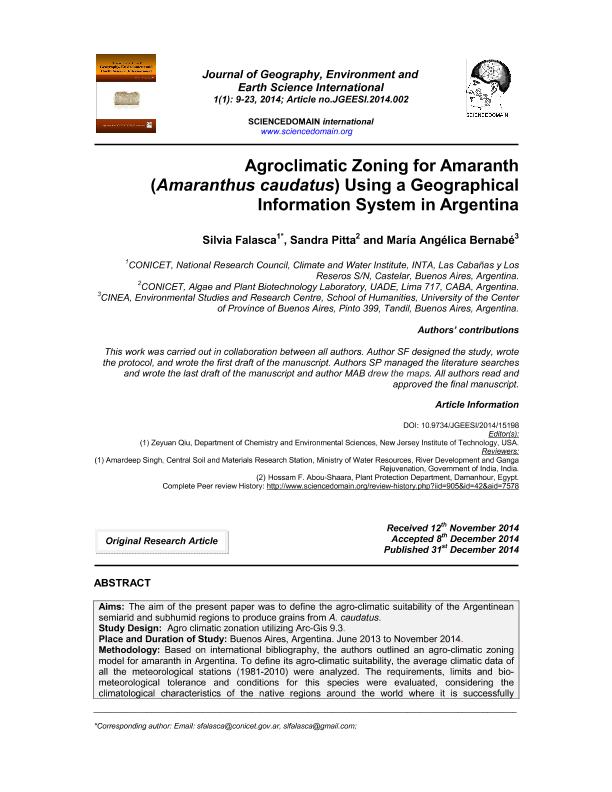Artículo
Agroclimatic Zoning for Amaranth (Amaranthus caudatus) Using a Geographical Information System in Argentina
Fecha de publicación:
12/2014
Editorial:
SCIENCEDOMAIN international
Revista:
Journal of Geography, Environment and Earth Science International
ISSN:
2334-2447
Idioma:
Inglés
Tipo de recurso:
Artículo publicado
Clasificación temática:
Resumen
Aims: The aim of the present paper was to define the agro-climatic suitability of the Argentinean semiarid and subhumid regions to produce grains from A. caudatus. Study Design: Agro climatic zonation utilizing Arc-Gis 9.3. Place and Duration of Study: Buenos Aires, Argentina. June 2013 to November 2014. Methodology: Based on international bibliography, the authors outlined an agro-climatic zoning model for amaranth in Argentina. To define its agro-climatic suitability, the average climatic data of all the meteorological stations (1981-2010) were analyzed. The requirements, limits and bio-meteorological tolerance and conditions for this species were evaluated, considering the climatological characteristics of the native regions around the world where it is successfully cultivated. To obtain the maps, a series of previously interpolated bioclimatic variables were used. The agro-climatic indices, which determine different classes of suitability, were integrated in a Geographic Information System to create thermal and moisture regions. The maps elaborated (frost-free days, annual rainfall, annual temperature and average temperature during growing period), were superimposed to determine the agroclimatic zoning. Results: Nine classes of agroclimatic suitability under three different climatic conditions were delineated: humid, subhumid and semiarid. Agro-climatic zoning identifies areas with different potential yields, as per their environmental conditions. This is an innovative work, made by the implementation of a Geographic Information System that can be updated by further incorporation of complementary information. Conclusion: Because of its low hydric requirements, amaranth is a promising dry land crop for farmers in subhumid and semiarid areas of Argentina. Its cultivation would also be recommendable in optimal, very suitable and suitable areas under humid climate on moderately-highly saline soils and moderately alkaline soils, so as not to displace the traditional crops of Humid Pampas. This model may be applied in any part of the world, using the agroclimatic limits presented in this paper.
Archivos asociados
Licencia
Identificadores
Colecciones
Articulos(OCA CIUDAD UNIVERSITARIA)
Articulos de OFICINA DE COORDINACION ADMINISTRATIVA CIUDAD UNIVERSITARIA
Articulos de OFICINA DE COORDINACION ADMINISTRATIVA CIUDAD UNIVERSITARIA
Citación
Bernabé, María Angélica; Falasca, Silvia Liliana; Pitta Alvarez, Sandra Irene; Agroclimatic Zoning for Amaranth (Amaranthus caudatus) Using a Geographical Information System in Argentina; SCIENCEDOMAIN international; Journal of Geography, Environment and Earth Science International; 1; 1; 12-2014; 9-23
Compartir
Altmétricas




